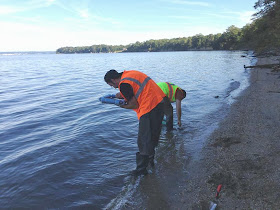While we weren't able to locate the main cavalry camp, the property we were searching was most likely home to a smaller picket, or advance guard post. Extremely dry conditions and other complicating factors made for difficult detecting, but we still both managed a handful of nice relics. We recovered a total of twelve Civil War bullets over the course of a few hours in the field. Most were standard three ring Minie balls, but Phil recovered a round musket ball and one particularly neat carved Sharps carbine bullet.
Phil also found the odd shaped piece of brass in the same photo later in the day. What is it? Phil correctly ID'ed it in the field as the chape (part of the inner workings) from a colonial era shoe or knee buckle. It's important to remember that roads used by soldiers were around long before the war. It isn't at all uncommon to find colonial era relics scattered in with Civil War era ones, particularly around old roads and homes.
Some readers may recall back in April I recovered a fragmented piece of a colonial shoe or knee buckle, and lamented that I had not yet found a complete frame. One of my first recoveries today happened to be this complete colonial era knee buckle frame, likely predating the War between the States by 50-100 years. While researching images of complete knee buckles for this post, I happened across a picture showing an almost identical knee buckle with a chape that matches the one Phil recovered. It was only then that I put the pieces together in my mind - we had both found parts of the same buckle! Only the prongs remain to be found, and we hope to look for them on a return trip sometime in the future. In the interest of preservation, the frame and chape will be reunited the next time Phil and I get together.
I really couldn't have asked for a better day out relic hunting. Thanks so much to Phil for coming out, it's always more fun to share the experience with a friend. Thanks also to the generous landowners for allowed us the opportunity to detect. I'm extremely grateful for the beautiful weather, the good finds, and the chance to share that experience with all of you. Once again, until next time, thanks for reading and God Bless!













